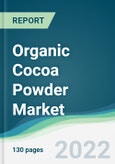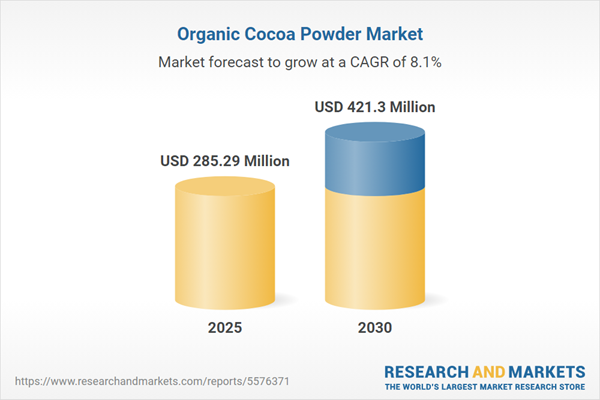The organic cocoa powder market is expected to grow at a CAGR of 8.11%, reaching a market size of US$421.297 million in 2030 from US$285.292 million in 2025.
Cocoa is a potent source of polyphenol, an antioxidant that helps to decrease blood pressure and reduce swelling. Due to their versatility in product formulation, cocoa-based items are very popular in the food and beverage industry. It also provides healthy nutrient content to the body and is used to prepare dark chocolate.
The two main reasons responsible for the organic cocoa powder market's growth include increased awareness among consumers regarding the health benefits associated with chocolate consumption, especially in recent years among developing economies, and increased individual household income levels. This market growth is also attributed to the increasing application of the powder in the treatment of drugs due to its antibacterial and anti-enzymatic properties. There is also a rising demand for food-grade cocoa powder in the food and beverage market.
The market for organic cocoa powder will extend to additional growth opportunities due to the increasing scope of sustainable cocoa farming practices adoption. A rise in the market share of organic cocoa powder will occur due to the increasing use of online shopping platforms, the growth and expansion of the e-commerce market, particularly in emerging markets, and the adoption of Western culture. The market share will grow as a focus on Cocoa powder as a core implementation in creating new food and beverage products grows.
Cocoa processing and production companies are also focusing on investments in developing new products to reach a wider scope of customers, which will also be a factor for market growth. In the future, it is anticipated that the advancement of the organic cocoa market will be propelled by the expansion of the organic food supply chain and the improvement of organic agricultural methods..
Cocoa is a potent source of polyphenol, an antioxidant that helps to decrease blood pressure and reduce swelling. Due to their versatility in product formulation, cocoa-based items are very popular in the food and beverage industry. It also provides healthy nutrient content to the body and is used to prepare dark chocolate.
The two main reasons responsible for the organic cocoa powder market's growth include increased awareness among consumers regarding the health benefits associated with chocolate consumption, especially in recent years among developing economies, and increased individual household income levels. This market growth is also attributed to the increasing application of the powder in the treatment of drugs due to its antibacterial and anti-enzymatic properties. There is also a rising demand for food-grade cocoa powder in the food and beverage market.
The market for organic cocoa powder will extend to additional growth opportunities due to the increasing scope of sustainable cocoa farming practices adoption. A rise in the market share of organic cocoa powder will occur due to the increasing use of online shopping platforms, the growth and expansion of the e-commerce market, particularly in emerging markets, and the adoption of Western culture. The market share will grow as a focus on Cocoa powder as a core implementation in creating new food and beverage products grows.
Organic cocoa powder market drivers
Rising demand for organic food products is contributing to the Organic cocoa powder market growth
Globally, consumers' fast-paced contemporary lives have altered purchasing food in a very short time. Consumers tend to gravitate towards more products that ensure protection and promote health enhancement. It is safe to grow organic products because they do not require the use of pesticides. This pulls the cocoa market in the food and beverage sector into an optimistic outlook due to consumers' increasing demand for organic and pesticide-free food products. The market has also expanded in recent years as people look for organic chocolate confectionery, desserts, bakeries, and drinks.Cocoa processing and production companies are also focusing on investments in developing new products to reach a wider scope of customers, which will also be a factor for market growth. In the future, it is anticipated that the advancement of the organic cocoa market will be propelled by the expansion of the organic food supply chain and the improvement of organic agricultural methods..
Organic cocoa powder market geographical outlook
North America is witnessing exponential growth during the forecast period
The organic cocoa products market is well developed in North America, where consumers appreciate its benefits and look for the best clean food. Here, the segmented market of health-conscious consumers prefers organic chocolates. Key market players, a well-established retail network, and the availability of a wide variety of organic cocoa products have contributed to this market. Moreover, it is another market opportunity for organic cocoa products with strict organic standards and a strong focus on natural farming. The market growth is due to the presence of many dairy chocolatiers, a well-organized supply chain network, and the demand for high-end organic cocoa products among consumers.Reasons for buying this report:
- Insightful Analysis: Gain detailed market insights covering major as well as emerging geographical regions, focusing on customer segments, government policies and socio-economic factors, consumer preferences, industry verticals, other sub-segments.
- Competitive Landscape: Understand the strategic maneuvers employed by key players globally to understand possible market penetration with the correct strategy.
- Market Drivers & Future Trends: Explore the dynamic factors and pivotal market trends and how they will shape up future market developments.
- Actionable Recommendations: Utilize the insights to exercise strategic decision to uncover new business streams and revenues in a dynamic environment.
- Caters to a Wide Audience: Beneficial and cost-effective for startups, research institutions, consultants, SMEs, and large enterprises.
What do businesses use our reports for?
Industry and Market Insights, Opportunity Assessment, Product Demand Forecasting, Market Entry Strategy, Geographical Expansion, Capital Investment Decisions, Regulatory Framework & Implications, New Product Development, Competitive IntelligenceReport Coverage:
- Historical data & forecasts from 2022 to 2030
- Growth Opportunities, Challenges, Supply Chain Outlook, Regulatory Framework, Customer Behaviour, and Trend Analysis
- Competitive Positioning, Strategies, and Market Share Analysis
- Revenue Growth and Forecast Assessment of segments and regions including countries
- Company Profiling (Strategies, Products, Financial Information, and Key Developments among others):
The Organic cocoa powder market is analyzed into the following segments:
By Distribution Channel
- Online
- Offline
By End-User Industry
- Beverage
- Food
- Bakery
- Others
- Cosmetic
- Household
By Geography
- North America
- South America
- Europe
- Middle East and Africa
- Asia-Pacific
Table of Contents
1. INTRODUCTION
2. RESEARCH METHODOLOGY
3. EXECUTIVE SUMMARY
4. MARKET DYNAMICS
5. ORGANIC COCOA POWDER MARKET BY DISTRIBUTION CHANNEL
6. ORGANIC COCOA POWDER MARKET BY END-USER INDUSTRY
7. ORGANIC COCOA POWDER MARKET BY GEOGRAPHY
8. COMPETITIVE ENVIRONMENT AND ANALYSIS
9. COMPANY PROFILES
Companies Mentioned
- Barry Callebaut
- BATA FOOD
- Royal Forest
- Little Plant Pantry
- Neotea
- Navitas Organics
- Cacao Forest
- Naturevibe Botanicals
- Cargill
Methodology

LOADING...
Table Information
| Report Attribute | Details |
|---|---|
| No. of Pages | 130 |
| Published | November 2024 |
| Forecast Period | 2025 - 2030 |
| Estimated Market Value ( USD | $ 285.29 Million |
| Forecasted Market Value ( USD | $ 421.3 Million |
| Compound Annual Growth Rate | 8.1% |
| Regions Covered | Global |
| No. of Companies Mentioned | 9 |









